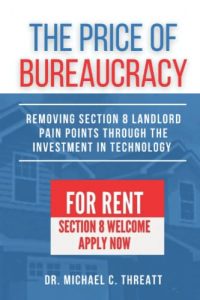What are the Top 5 Section 8 Landlord Pain Points & Solutions to Remove Them
By Dr. Michael C. Threatt, Author of The Price of Bureaucracy: Removing Section 8 Landlord Pain Points through the Investment in Technology

However, this relationship appears to be a two-sided partnership instead of a three-way as the Section 8 program was designed in 1974. When this three-way partnership works well, all parties win; however, when one or more of the partners are unsatisfied, all parties lose. More specifically, the landlord is the least satisfied and engaged of the three parties. The landlord experiences numerous pain points that create negative experiences and are the reason for their withdrawal from participating in the Section 8 Program.
The Price of Bureaucracy: Removing Section 8 Landlord Pain Points through the Investment in Technology is the game-changing solution to cultivate better relationships between landlords and PHAs. This book was written with the Section 8 landlord in mind. The book focuses on innovative solutions to increase landlord satisfaction, improve communication, and enhance customer service to cultivate better PHA-landlord relationships by investing in technology.
Landlords’ perception of the Section 8 Program is institutional bureaucracy, and the bureaucratic red tape is their reality. Coincidentally, this is the unintended consequence of the price of bureaucracy which equals pain points for landlords.
The future of affordable housing depends on the success of the Section 8 Program, and the future of the Section 8 Program depends on landlords. Landlords are critically relevant to the success of the Section 8 Program because, without landlords, there are no affordable housing units to lease.
However, landlords feel like they do not have a voice, no support, and no one validates their opinions. I decided to do the opposite and validate the landlords’ opinions. As the Section 8 Landlord Coach™ and a licensed REALTOR®, I felt my responsibility was to be the ‘superhero’ who stood up for landlords and helped solve this affordable housing problem.
“During the summer of 2020, during the COVID-19 pandemic, while writing my dissertation, I was dealing with delayed payment challenges and other pain points as a Section 8 landlord myself. That’s when I noticed that my Section 8 landlord clientele were either threatening to or taking their units off the program. I had an epiphany and decided to focus my research on landlord opinions on how to make the Section 8 program better. A year later, in 2021, I started transforming my dissertation into a book.
Landlords are not interested in leasing their units through the Section 8 Program because of these five pain points, the lack of modern-day housing software (landlord portal), landlord webpage, and landlord liaison position and having to deal with the daunting inspections process, and the bureaucratic red tape. The top five pain points listed below correlate with negative experiences, which result in landlords withdrawing from the Section 8 Program altogether.
Modern-Day Housing Software (Landlord Portal)
Pain Point: Traditionally, the PHA sector of the real estate industry has been slower at adapting to new technology and reluctant to invest in the latest technologies similar to the private sector. However, the changing technological environment compels PHAs to use modern-day housing software for efficiency to improve communication and enhance customer service. It is challenging to maintain a responsive landlord relationship without modern-day housing software that includes a landlord portal to administer the Section 8 Program. Many PHAs need an online platform for landlords to submit web-based forms that allow landlords to sign, complete and submit transactions electronically without coming into the office.
Solution: PHA should invest in modern-day housing software that includes a 24/7 access landlord portal that provides e-signature for HAP contracts, leases, and other forms. The landlord portal also offers secure access for landlords to manage their Section 8 rental portfolio, including rent increase requests and financial information such as direct deposit payments and 1099 forms. Finally, the landlord portal provides access to monitor the entire lease-up process online, from the Request for Tenancy Approval (RFTA) to the Housing Assistance Payment (HAP) contract signing to real-time inspection status information to simplify the inspection process.
Landlord Webpage
Pain Point: PHAs with websites lack a responsive webpage focused on landlords. Most Section 8 Program webpages on PHA websites are focused on Section 8 voucher holders and the PHA’s role.
Solution: A PHA webpage should display landlord-friendly language to address questions upfront by providing customer service to attract, recruit, and retain landlords. The webpage should have language for potential landlords or former landlords interested in returning to the Section 8 Program, including a landlord newsletter, rental calculator, and payment standards (fair market rents in the area). The webpage should display language written for the audience of real estate investors, property managers, business entities, and other small mom-and-pop landlords.
Landlord Liaison Position (Point of Contact)
Pain Point: Many landlords feel that there should be one designated person (i.e., landlord liaison) dedicated to working with them. Unfortunately, many PHAs choose not to fund the landlord liaison position because they do not understand its vital role in recruiting and retaining landlords. Only a tiny percentage of PHAs have the landlord liaison position budgeted for their Section 8 Programs. Some landlords feel like they do not have a voice, their opinions are ignored, and their feelings of dissatisfaction are not validated.
Solution: PHAs should make the landlord liaison position a budget line item for their Section 8 Programs. The landlord liaison staff position is the single point of contact for landlords devoted solely to providing customer service and communication on their units or any updates regarding the Section 8 Program. This position is essential in helping landlords feel like they are actual customers of the Section 8 Program. The landlord liaison listens to landlords’ issues, opinions, and concerns regarding bureaucratic red tape. The position addresses paint points to attract and recruit new landlords and rekindle the fire of current and former landlords.
Daunting Inspections Process
Pain Point: The Section 8 Program inspection process has become too complicated for current landlords to navigate and deters new landlords from participating. Waiting on Housing Quality Standards (HQS) Inspectors to inspect landlords’ units for hours instead of utilizing effective communication through technology is a huge deterrence. Based on the HQS Inspectors’ discretion, some pass or fail inspections subjectively; the program’s inconsistency turns landlords off.
In fact, some PHAs are still using carbon copies for their HQS forms. Additionally, waiting to learn the results through the mail of whether an inspection passed or failed or if the HAP payment will continue or stop without knowing the inspection status for days or weeks is a daunting task for a landlord. This significant issue of waiting for a mailed HAP payment because the PHA has yet to embrace a technological environment.
Solution: Simplifying the inspection process through technology is an essential step to looking at the inspection process through the eyes of the landlord to address their pain point. Technology can notify the landlord through text messages, phone calls, and email with changes to HQS inspection appointment times or if the HQS Inspector is within 30 minutes of the property.
The inspection process should be completed efficiently on a tablet or smartphone utilizing modern-day housing software to upload real-time inspection results to meet HUD mandates and simplify the inspection process by making it landlord-friendly and informative.
The inspection results should be uploaded in real-time and should be accessible through the PHA’s modern-day housing software’s landlord portal so that the landlord can make real-time business decisions about whether to repair the property, sell the property, issue a lease violation, etc.
Bureaucratic Red Tape
Pain Point: The overarching recurring reason for landlords’ withdrawal from the Section 8 Program was the consistent negative experience of dealing with bureaucratic red tape. A significant impediment that deters landlords from participating in the Section 8 Program is the confusing policies and practices of PHAs.
This problem is further escalated when landlords evaluate the cost of bureaucracy based on their experience dealing with the bureaucratic PHA. Renting to Section 8 voucher holders still comes with the price of dealing with the numerous layers of red tape. Also, some PHAs have negative reputations for slow, late, or incorrect payments and delayed rent increases.
Solution: Removing the bureaucratic red tape will develop better relationships between landlords and PHAs. This will improve the landlords’ experience as satisfied customers and treat them like mutual business partners. The pain points are alleviated when the PHA implements private-sector business practices and invests in technology. The price of bureaucracy for affordable housing in America has been paid in full. The time is now for the Section 8 Program to fulfill its purpose for Section 8 voucher holders by expanding housing opportunities and engaging landlords to return to a mutually beneficial relationship.
About the Author
Dr. Michael C. Threatt is a licensed REALTOR® with Community 1st Real Estate in Dothan. He is an executive-level affordable housing professional with over 16 years of experience working within the real estate industry’s public, private, and nonprofit sectors. Michael is also a podcaster, consultant, coach, author, and developer. Michael is the Senior Vice President/ Chief Operating Officer (COO) for Dothan Housing where he is responsible for the day-to-day operations. He is not only a 16-year veteran of the housing authority industry, but he also holds a doctorate in public administration from West Chester University, with a dissertation on landlords in the Section 8 housing choice voucher program.

















 Accessibility
Accessibility